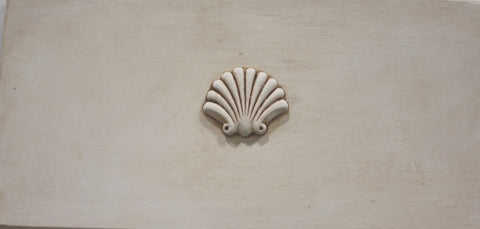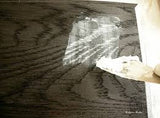Chalk Finish Paint Techniques - From Da Vinci
Below are a few ideas of achieving different techniques with Using Vintage paints Distressed chalk finish paint and Vintique talc Paint.

|
|
ANTIQUING
Da Vinci Chalk Finish is ideal for furniture refinishers & Upscaling because it adheres to most surfaces, without fail and with very little surface preparation. In other words: no stripping, little or no priming. Once you have Da Vinci Distressed Chalk Finish paint has been painted onto the surface of a piece of furniture, the resulting coat of paint feels a lot like chalk. It is very matt and very porous. To protect this coat of paint, apply a coat of Da Vinci SOFT-WAX clear wax over the entire piece which will result a satin clear finish. To give your project an antiqued look, apply a coat of Da Vinci ANTIQUING Soft wax over the clear (By having the clear on first makes applying the dark wax a lot easier and gives the ability to build up slowly). The difference between clear wax and dark wax is pretty striking.
Dark antiquing soft wax makes its appearance of shabby chic aged look. Slipping into the cracks and crevices of any piece of furniture, dark wax highlights all the details and carvings, scratches and grooves. It also adds a light stain to the smoother surfaces of the piece.
Materials:
Soft wax Clear & Antique Dark wax, Wax Brush (or natural bristle Brush) , & rags
|
 |
|
DISTRESSING (2 different ideas)
There are a lots of different techniques and ways to distress your project and everyone has their preference. Here's a few ideas.
Each technique is a little different as too are the results You may find that one of these distressing techniques is going to become your preferred technique for most of your projects. Distressing is fun and interesting as you can truly create a unique look!
Keep this in mind before starting your project:
1) The best temperature to apply paint is room temperature. (don't paint in direct sunlight) That’s also the best condition to let your paint dry. If it’s too cold or humid, the paint will take longer to dry, so just keep that in mind.
2) Try out the below techniques on “sample pieces of wood” so you can get used to them before using them on a piece of furniture.
Wet-Distressing Technique
This is a popular technique for when you're layering colours, because you can use it to create a “natural” looking worn effect.
(1) The first coat .Apply one coat of paint to your piece; let it dry completely. We recommend letting the first coat dry for at least 1-2 hours when you are using the wet-distressing technique.
(2) The second coat .Apply a second coat in a contrasting colour. Wait about until the paint is dry to the touch. (Remember that even though the paint feels dry, it’s still fresh and it hasn’t reached its full “hardness” yet. That’s what you’re taking advantage of when you’re using the wet-distress technique.)
(3) Distressing. Once paint is dry, get a bucket of water and a lint free rag or scouring pad . Make sure that your cloth is damp but not dripping wet. Use the damp rag or scourer to gently rub across the surface in a back & forth motion. Apply minimum pressure at first, because you don't want to take off more of the paint layer than you intend. You can always apply more pressure if you’d like.You can choose to distress only the edges of your piece or to distress it on the flat surfaces as well. If it comes out too distressed you can always choose to cover with another coat of paint and start the distressing process again.
Dry-Distressing Technique
This is a great technique to use when you’re using a single colour on a piece of furniture and want to expose the original wood layer
(1) First Coat. Apply a coat of paint to your piece; let it dry.( If raw wood or MDF, then it’ll likely be needy for its second coat within an hour). We recommend a light sanding oved existing paint or varnished wood before the first paint coat and allow to dry before applying your 2nd coat).
(2) Second Coat. If needed, apply a second coat in the same colour to get the desired amount of coverage. Wait until the paint is dry to the touch.
(3) Distressing. Okay now your final paint coat is dry, you can start distressing it with fine-grit sandpaper. You can start with 180-220 grit sandpaper to see how you like the look, ( i like 220 to 320grit as is slower but gives you better control) but feel free to experiment with other grits. (The higher the number, the finer the sandpaper.) Don’t want to use sandpaper that’s too coarse as it’ll leave visible marks on the undistressed parts of your piece! You can also use sanding sponges or a sanding block. These will be a lot easier to work with than plain sandpaper. They’ll also be less likely to leave visible marks on your surface.Make sure to apply only a little pressure at first, because you don't want to take off more of the paint layer than you intend. You can always apply more pressure if you’d like
Hope this helps!
|
 |
|
RAISED PLASTER & CHALK FINISH PAINT STENCIL
This is a great technique that is inexpensive and give a carved wood effect that can be used on furniture, doors and walls
Tools you will need
-
-
-
-
-
Brush or Scraper
-
Masking Tape
Right now you are ready to go.
(1)First follow instructions on our stencil page regarding the placement, lining up and taping of each stencil.
(2)Mixing: For best results in a separate container mix about 250ml (by Volume) of chalk Powder and pour a little of Roma wash and stir do this only enough that the chalk powder is wet and no dry powder is then. You should be able to almost put 150-250mls of Distressed chalk finish paint with powder mix (any colour can be used regardless if painting over or not) and mix until you achieve a thickish consistency ( a bit wetter than a painters filler)
(3)application:(do horizontally or lying down if possible) you can apply with a brush , a scraper or even a knife. Push down onto stencil , smooth as much as you can (don't be too concerned if its not perfect as you can sand or leave to add character). You should be able to get at least 4mm in height without too much slumping. Let set for about 20-30 minutes and carefully remove stencil and wash so it can be reused.
(4) Finally leave overnight to harden as will take longer to dry than paint. You can as done in this picture uses some kids paints to make pretty or overpaint and sand back high spots to create a rustic look.
Once done this will be a one of a kind effect that looks amazing. You can take a plain Board and create some spectacular effects.
|
|

Crackle Finish with Chalk Paint Finish
Tools you will need
-
2 colours of Da Vinci Chalk Finish
-
PVA Glue
-
Hair Drier or hot air gun
-
Roma Wash
Right here we go....
I love this technique, it is an imperfect crackle so looks more natural. You will see some spray can crackles that are small and perfect this technique varies which makes it look that much better.
Hints to make a good job
-
the thicker the PVA the thicker the crackle
-
use two contrasting colours such as Blue/white, white/gold, white/black etc.
-
work in areas no larger than 400mm x 400mm
Okay
-
step 1- apply base coat of da Vinci Chalk finish paint.
-
Step 2 allow to dry for 1-2 hours
-
Step three apply a coat of PVA Glue to base coat
-
Step 4 mix top coat (one part Roma wash to one part Chalk finish)
-
Step 5 apply diluted coat on still wet PVA ( I normally let PVA tack off for about 2 minutes). This feels abit stange doing this as you need to brush paint over PVA not mix in.
-
Step 6 blow hot air over wet paint to force cracking. Blow driers may take a few minutes to show an effect
Hope it turns out the way you want , I think it looks amazing..
|
|

Rag Flicking
Tools you need
-
2 plus colours of chalk paint
-
Romawash
-
Soft long lint free rags
This technique can be a bit messy so make sure you have covered areas and floors with a drop cloth.
First apply a base coat normally a light unthinned coat of Da Vinci Chalk Finish. Once dry you can apply the flick effect. For best results i thin Chalk finish one to one with romawash and get end of rag and cut end of rag into strips ( at the end of the rag) Now Dip the end of the rag in to diluted paint and in a whiping motion whip the rag on to the base colour at different angles. Doing this with more than one colour is really effective. The sample shown here is three tone (Yellow,blue,green) with bright colours to show the effect but works really well with earthy tones. I have done my daughters walls in her bedroom with this effect and hid imperfections in wall really well.
|
 
|
|
Liming Pickling (using Liming white wax)
You will need:
-
wax or bristle brush
-
rag
-
Da Vinci Soft wax Liming
The “white wash” finish is another term for liming.
When liming or pickling a piece, you should start with using a wood with an open, loose grain; like oak or if painted use the a cross brush technique to achieve brush marks for the liming wax to fill the pores.. The open grain or brush marks allows for the liming wax to fill into the grain as opposed to the moldings. It also works on vivid colored pieces to make them less vibrant if you are looking to create more of a pastel color.
|







